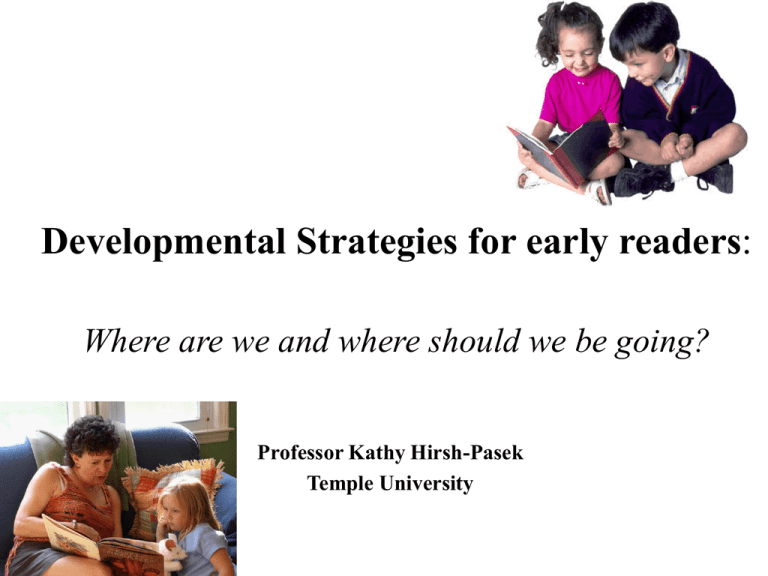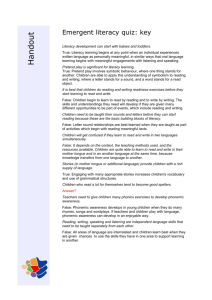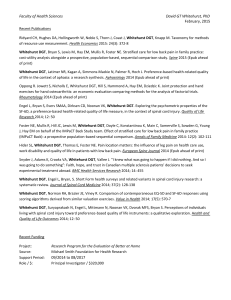Developmental Strategies for early readers - Kathy Hirsh
advertisement

Developmental Strategies for early readers: Where are we and where should we be going? Professor Kathy Hirsh-Pasek Temple University Early childhood on the front page! • Learning starts here • (PA Library System, 2004) • Born Learning • Civitas; Family and Work Institute • No Child Left Behind • Government accountability • America’s Promise • Marketable skills WHY? Because… • The gap between rich and poor – 25% of low income families have fewer than 10 age appropriate books in their homes (Whitehurst) – Vocabulary disparities • Children ages 0-6 are spending more time on entertainment media than on reading, being read to and playing outside combined (Rideout, 2003) • Language and literacy skills are the single best predictors of later academic success WHY? Because… • There is a clear research basis telling us which developmental strategies work for promoting language and literacy • We know that intervention helps! • • • • Head Start Early Childhood Longitudinal Study High Scope Abecedarian A talk in 6 parts • Introduction: – Burnout on the front lines • Language Development: – The foundation for reading • Narrative development – Where language meets reading • Literacy • Writing – A partner for reading • Conclusions Burnout on the front lines Even if it is with the best of intentions……. Examining the pressures • No Child Left Behind – Good idea /bad execution • Accountability – Outcomes vs. process • Testing: The problem – “You can’t fatten a pig by weighing it” • Closing the gap between teaching and testing – Forging a new road: • from language to narrative to literacy to writing Language Development The foundation for reading What you see: Landmarks in production • • • • • 0-3mo: coos, burps 3-6 mo: coos; laughs, cries, gurgles 6-9 mo: babbling; turn taking; pat-a-cake 9-12mo: points; first words; Bam Bam 12-18mo: 2 words per week; 50 words at – 18 mo., names for body parts, animals, imitates • 18-24 mo: naming explosion; “Whas sat?; – Talk about here and now; loves stories over and over;follows simple commands What you see continued • 2-3 yrs: 500 wds; asks questions; – past tense; Wh-; sits 20 minutes; WHY?; pronounce clearly m,n,f,b,d,h,y; uses fuller sentences with “in,” and “on.”; girls might appear to stutter • 3-4 yrs: 800 wds; contractions - won’t; – can’t; can follow plot in story line; time words - morning; afternoon; adds sounds k,g,r,l; may still distort v,sh,ch,j and th; wonderful new made-up words like, “Michael wave” or “vampire” What you see continued • 4-5 yrs: 2000 words; speaks clearly most – of the time; can make up stories; use complex sentences; still might mispronounce s,r,th,t,v,sh,ch, j. • 5-7 yrs: retells stories with more depth; – participates in discussions; learns relationships like big/little/happy/sad • • • • 1st grade: 11,000 words 3rd grade: 20,000 words 5th grade: 40, 000 words YOU: 52,000 words Big jump in school age: What causes this? Addition of derived words like sadness, manager… Kids seems to have root words and inflected words and idioms but greatly add in compounds and derived words Beyond words to conversations • Building vocabulary through dialogue • Questions not answers • Playing with language – Jokes – Games – You’re mama…. Cautionary notes • Pediatricians have had this chart for a long time • Different strokes for different folks – Groups – Individuals • It’s not all over at 4 years! There is a lot of variation and what I showed you are just general guides to the patterns in language development The role of language in reading Two models Indirect and direct Model 1: Language plays in indirect role in early (1st grade) reading Oral Language Comprehensive Oral language: Comprehensive Oral language: Vocabulary Vocabulary Code: Reading Comprehension 36 mo. Code Skills: Phonemic awareness Code Skills: Phonemic awareness Reading readiness Reading readiness 54 mo. 1st grade 3rd grade Direct Model 2: Language plays both a direct and indirect role in early (1 st grade) reading Oral Language Comprehensive Oral language: Vocabulary Comprehensive Oral language: Vocabulary Code: Reading Comprehension 36 mo. Code Skills: Phonemic awareness Code Skills: Phonemic awareness Reading readiness Reading readiness 54 mo. 1st grade 3rd grade Given the importance of language for reading….. What can you do to help language growth? Enhancing language • Talk with not at children – Hart and Risley – Responsive, contingent conversations on their topic of interest • Read, read, read and read some more – Dialogic reading (Whitehurst) • Vocabulary games – Snark, snarkist, snarkly • Taking the Latin and Greek out of English – Heal and health • Tell stories -- from you, jointly Narrative Structuring the stories of our lives Stories • The role of stories – From Thanksgiving to Christmas • Grids for experience • Decontextualized language – Distance between sender and receiver – Complex sentence structure – High degree of cohesion The Structure of Narrative • • • • Setting (place, characters) Initiating event Problem Resolution Most 3 year olds have setting, most 5 or 6 year olds have parts with no embellishment, most 10 year olds have full plots. Cross cultural differences • Asian – “mouth is source of misfortune” • African American – topic association rather than topic centered; performance, exaggeration • Caucasian American – Topic centered rather than topic association Respect individual differences! Literacy A definition The earliest sign of a child’s interest in and abilities related to reading and writing. Whitehurst & Lonigan, 1998 The case of 12 month old Kelly and 21 month old Jim Key components of emergent literacy • Phonemic awareness – To understand that speech is composed of units • Letter recognition – The ability to associate letters with appropriate sounds • Awareness of print – The understanding of print and word conventions • Early writing development – Attempts to produce written text (scribbling, invented spelling) • Oral development – Vocabulary, discourse and narrative How we help children learn these skills? • Talk with them • Tell stories • Read aloud and expose children to print • Targeted learning of code skills and phonological development Reading aloud • Going beyond the covers of the book • Reading the same thing over and over and over again • Using the book as a spark for conversation Reading aloud: What to avoid • “Shushing” -– the technical term for forcing silence • Reading every word as is with no breaks • Meaningless reading that children can’t identify with or understand – “Spot the dog” Targeting Phonological Skills: Code learning • Pointing out similar sounds • Rhyming games • Singing – An example • Playing the alphabet games • What starts with this letter/sound? • Creating print rich environments What to avoid • Boring repetition with no meaning • Only learning the 10 letters of the alphabet – Why MNOP is one letter! Writing Writing as…. • The right arm of reading – Tell a story -- write a story • Writing as relevant – Labeling your clothes – Getting your way • What you can do – Writing letters on issues that matter for children – Writing to stuffed animals or Santa Clause – You tell the end of a story and have the children write the beginning Interventions that work • Creating language rich environments – The castle on the hill -- in the classroom • Creating literacy rich environments – Signs and charts • Telling stories – While -- building forts, blowing bubbles • Learning to play and playing to learn PLAY = LEARNING Conclusions What’s happening in PA The way out of the crisis in education • Think process not just product – How you learn is as important as what you learn • Reclaim education – It’s for educators not for business people. Children are not widgets. • Close the gap – between what we know about how children learn and what we are doing in the classroom • Add PLAY to the equation Then we will have Smart and happy children in our classrooms today who become sensitive and creative adults in the workplace of tomorrow





